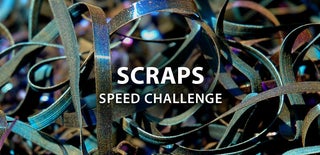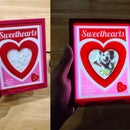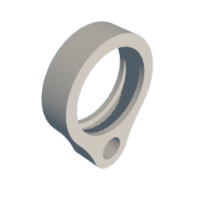Introduction: How to (Literally) Give Your $0.02
Admit it, there's been a time you wanted to give someone (or something even...) your "two cents" right?!?!
Well me too. Maybe we'll start a club or facebook group or whatever later. But for now I'm planning to show you how I combined my love of Bad Puns and my dislike for wasting 3D printer filament into a funny gag gift!
Lets star the Puns! Did you hear about the person who only collected rare pennies? Turns out they didn't have a lot of common cents...
(Please feel free to drop your favorite money pun in the comments!)
Supplies
A 3D printer
I'm using the same 3D printer I fixed in this Instructable
Leftover 3D printer filament
I'm using orange PETG in this Instructable, but any type of filament will work. This is a quick print so any scrap that's about 18 inches (450mm) or longer will work great.
The .stl file attached to this step
I also included a .3mf because Fusion gives that option now.
Two pennies
I've included the Fusion 360 and .STP model files if you would like to resize it to fit a different coin.
A keychain ring
These are the rings I'm using. You can also put them on some earring studs if you're feeling extra punny.
Elmers purple glue stick
Since I'm printing on glass, glue stick or blue tape works well. Someday I'll upgrade to a magnetic plate... If you have a different build surface use what works best for you.
Step 1: Gather Scraps
The scraps for this are typically generated in two ways at my laboratory
- Commonly I end up with a small amount of filament left on a roll and I have trouble throwing it away. If you have a 3D printer I'd be willing to bet you have a couple spools with a little left on them as well.
- When the filament runout sensor on my big 3D printer trips I end up with about 3 feet of filament leftover between the print head and the runout sensor.
Bad pun for this step: What does the moon and $1 have in common? Both of them have 4 quarters
Step 2: 3D Printing and How to Capture the Coins
Where do penguins keep their money? In a snow bank! And fish? Yep, they keep their money in a river bank... Ba, dum, tiss!
Yeah I know... don't quit my day job right?!?! 🤣
Anyhoo, In this example I'm using orange PETG from Zyltech. I'll also share my PLA settings.
Import the .stl file from the previous step into your slicer. I'm using Simplify 3D, Cura is an excellent option as well. The file should import as shown in the first picture, but if it doesn't just make sure one of the flat sides is on the bed.
PETG settings - .4mm nozzle, .2mm layer height, 2 shells, 3 bottom layers, 3 top layers, 2mm retraction, no cooling fan, 20% infill, 45mm/s speed, 242*C hot end, 65*C bed.
PLA settings - .4mm nozzle, .2mm layer height, 2 shells, 3 bottom layers, 3 top layers, 1mm retraction, 100% cooling fan after layer 3, 20% infill, 60mm/s speed 210*C hot end, 45*C bed.
OK, slice it and then launch your print. I'm printing on glass so I've given it a light coat of elmers glue. Really can't wait for my new magnetic bed... but that's not important... back on topic.
Pause your print at 5mm. On this QIDI printer I do this by setting "Pause at Z POS" in the print menu. It is possible to add a pause in the Gcode, I'll add the script for that in the last step since it's a little different for this printer, but for now let's just pause manually since this is a really quick print.
OK, once the printer has paused insert your coins into the pocket created. Make sure they're flush with the top or the extruder can catch on them. Now resume the print. The whole process start to finish takes around 15 minutes or less.
Step 3: Finish It + Bonus Gcode!
What do you call it when you get a loan from a Bison? A buff-a-loan! 😁
So, that's it, go put it on your keychain or put it on it's own keychain and give it to someone who need a laugh!
Now, one thing to be aware of is that sometimes when the layer above the penny starts there can be a string or two that doesn't stick quite right. This is easily trimmed with a hobby knife and you're good to go again!
Also, also - you can do heads and tails. And you can make them into earrings. And you can?!?!? - I'm sure there's some other fun things then can be turned into, give it a shot and let me know what you came up with!
OK, that'll wrap up the main portion of the program for today. If you want to talk some 3D printing Gcode, keep reading! If not, thanks for reading this far and I'll catch you next time!
----------------------------------------------------------------------------------------------
Lets talk how to add a pause at a specific height directly into the 3D print program so we don't have to remember to do it manually -
On my printers that run Sailfish firmware I haven't really every messed with the Gcode since it's a little different. So I took this Instructable as an opportunity to finally dig a little deeper and figure out how to make it work.
3D printer firmware discussion is a bit beyond the scope of what I want to go into today, but if you want to read more I found this link gives a good overview of the different types https://reprap.org/wiki/List_of_Firmware
Sailfish is found on many Makerbot Replicator style printers, my Flashforge and my QIDI both run it. One of the main differences is that Sailfish runs on .x3g files whereas many of the other types of firmware read .gcode files. There are other differences but this is one that matters for today's discussion.
To start, I dug into gcode commands (actually M codes... I had to look up the difference. The best explanation I found is G codes are for "geometric" commands and M codes are generally "machine" commands). Of all the links I read this is the one that I found most helpful. http://replicat.org/mcodes
I am not an expert GorMcode-er but after some trial and error this is the code I found that works for Sailfish and paused the print at 5mm. This text line is put into the script section of Simplify 3D, checkout the screen capture above.
{REPLACE "; layer 25," "M322 Z5.0\n; layer 25,"}
I know, I know... 5mm doesn't show up anywhere in the code... So how'd we get from millimeters to a print layer you ask? Well, In this case I cheated and made simplify 3D do it for me, screen captures are included above. We also know this is 5mm because we set the layer height at .2mm and .2mm X 25 = 5mm so the cheat code checks out. If you want to use this code, just change it to the layer you need it to pause at.
I can confirm this code does not work on a printer running Marlin... Also, I've learned there are about 17 different ways to accomplish the same outcome depending on your flavor of gcode. That's a long way of saying pausing your non Sailfish 3D printer with a gcode command will have to be an adventure for another day!
_______________________________
If you'd like to see what I'm up to when I'm not Instructable-ing you can also find me at these places:
My Website: https://www.makerneer.com/blog
Instagram: https://www.instagram.com/makerneer
Facebook: https://www.facebook.com/Makerneer/
Pintrest: https://www.pinterest.com/makerneer/
My Etsy Shop: https://www.etsy.com/shop/Makerneer
Note: My posts may contain affiliate links. Which means when you click the product links in my Instructable nothing changes on your end, and I earn a small % on qualifying purchases. Thank you for your support!

Participated in the
Scraps Speed Challenge

















